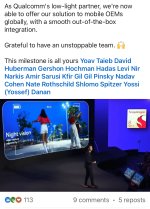SiFive Rolls Out RISC-V Cores Aimed at Generative AI and ML
October 2023 by
Jake Hertz
SiFive has released two new processors, one to target machine learning applications, and one to target general-purpose HPC.
The RISC-V movement is one of the hottest things in the computing industry at the moment, and arguably no company is more synonymous with RISC-V than Si-Five. With a long history of
producing industry-leading RISC-V processors, Si-Five has shown no signs of slowing down yet.
SiFive has released new processors to target machine learning and general-purpose HPC.
Last week, SiFive continued its momentum with
yet another set of launches: one new processor to target high-performance general-purpose computing, and another to target machine learning and artificial intelligence tasks. In this piece, we’ll take a look at the two new offerings from Si-Five to see what the company is bringing to the table.
P870/P870A: General-Purpose High Performance SoC
The first of the SiFive releases last week was the
Performance P870/P870A processors. Engineered for consumer applications and data centers, the P870 features a number of architectural innovations that make it a formidable processor.
First, the device is built around a 64-bit six-wide out-of-order core architecture that adheres to the RVA 23 standard, while also featuring a shared cluster cache that enables configurations of up to a 32-core cluster.
This is further complemented by augmented Arithmetic Logic Units (ALUs) and additional branch units as compared to previous offerings. It also incorporates advanced features like 128b VLEN RVV, vector crypto and hypervisor extensions, IOMMU, and a non-inclusive L3 cache.
SiFive‘s P870/P870A embeds more features than its predecessors.
Together, these architectural enhancements enable high throughput and low latency for the processor, making it ideal for applications that demand rapid data processing and real-time analytics.
The device is said to achieve a 50% peak single-thread performance upgrade over its predecessor, as measured by the specINT2k6 benchmark, while also offering improvements in execution throughput, facilitated by an increased number of instruction sets per cycle
The P870A variant, specifically designed for automotive applications, shares the core architecture with the P870 but is likely to include additional features tailored for the automotive industry, although detailed specifications are yet to be released.
Intelligence X390 Boosts Vector Computation
The second major release from SiFive last week was the
Intelligence X390 processor, designed to meet the escalating demands of AI and ML applications. The X390 builds upon the architectural foundation laid by its predecessor, the X280, but introduces several key enhancements that significantly boost its computational capabilities.
At the core of the X390 is a single-core configuration that offers a fourfold improvement in vector computation. This is achieved through a dual vector ALU setup and a doubled vector length, which collectively contribute to a quadruple increase in sustained data bandwidth.
The processor also incorporates SiFive's VCIX technology, allowing companies to add custom vector instructions or acceleration hardware, thereby offering unprecedented flexibility in performance optimization.
The processor's enhanced vector computation capabilities make it particularly well-suited for neural network training and inference tasks, which often require high computational power. Moreover, the X390's architecture is designed to facilitate a sustained data bandwidth increase, a critical factor for AI/ML applications that require rapid data ingestion and processing.
Performance metrics indicate that the X390 is a powerhouse in its category. It offers a quadruple increase in sustained data bandwidth due to architecture improvements and data width increases.
Pushing RISC-V Forward
SiFive is playing a pivotal role in propelling the RISC-V industry into new frontiers of performance and applicability. By unveiling processors like the Performance P870/P870A and Intelligence X390, the company is not merely iterating on existing technology but is introducing transformative architectural innovations.
Moreover, by setting new performance standards and expanding the scope of RISC-V's applicability, SiFive is accelerating the industry's move towards more efficient, flexible, and powerful computing architectures.

 www.linkedin.com
www.linkedin.com









